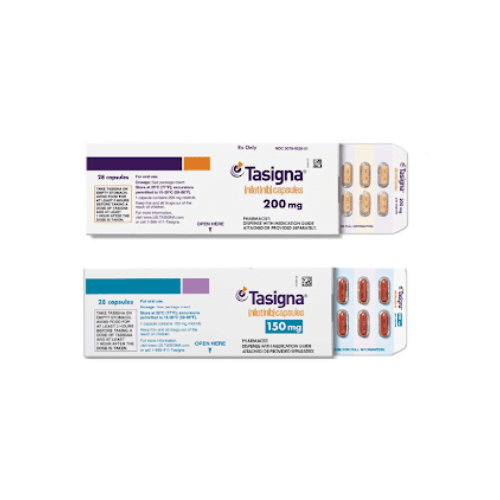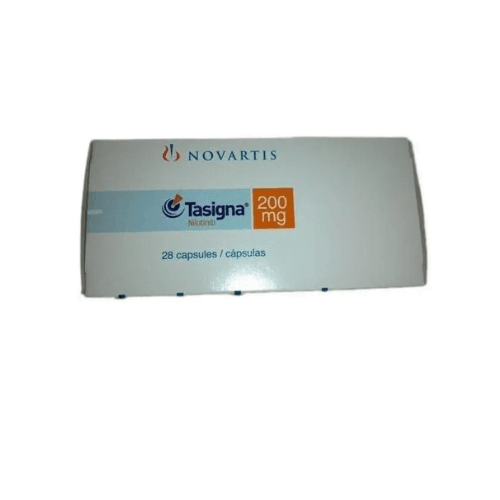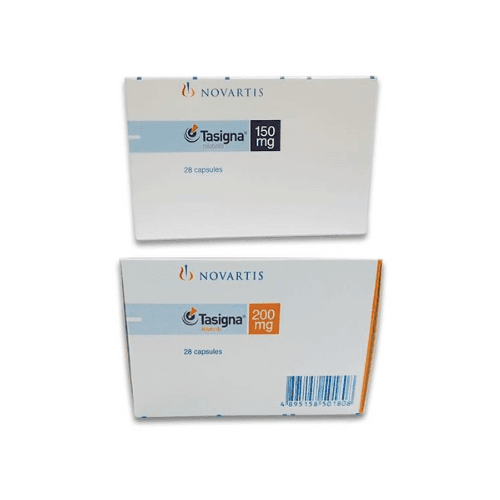Shipping with this method takes 3-5 days
Tasigna® Capsules for Chronic Myeloid Leukemia
Stock up and Save - Get 20% off when you buy 3 or more of any one product. Use code SAVE20 at checkout.
Coupon code cannot be combined with other offers. Sale applies to all products originating from Canada. Maximum allowable quantity equal to a 90 day supply per single order.
Price range: $3,843.99 through $5,418.99
Secure Encrypted Payments
Tasigna® is a prescription kinase inhibitor used to treat certain phases of Philadelphia chromosome–positive chronic myeloid leukemia in adults and children. It helps block BCR-ABL signaling, which supports control of abnormal white blood cells. You can order with US delivery from Canada, and many people compare Tasigna price without insurance before starting therapy.
What Tasigna Is and How It Works
Tasigna® contains nilotinib, a selective BCR-ABL tyrosine kinase inhibitor. It reduces leukemic cell proliferation by blocking ATP-binding to the abnormal kinase created by the Philadelphia chromosome. This medicine is used for newly diagnosed chronic phase disease and in patients resistant or intolerant to prior therapy, including imatinib, as described on the official label. YouDrugstore is a licensed Canadian pharmacy in Manitoba. Pharmacists review prescriptions before dispensing.
The treatment is taken on an empty stomach to optimize exposure and reduce safety risks. It carries a boxed warning for QT prolongation and sudden deaths. Your care team monitors ECGs and electrolytes. For more background on the condition, see our overview of Chronic Myeloid Leukemia.
Who It’s For
This therapy is indicated for adults and pediatric patients with Ph+ CML in chronic phase who are newly diagnosed. It is also used in chronic or accelerated phase Ph+ CML after resistance or intolerance to prior therapy. People with a history of long QT syndrome, uncontrolled hypokalemia or hypomagnesemia, or clinically significant cardiac disease may need a different option. Those with severe hepatic impairment require careful assessment. Pregnant or breastfeeding individuals should discuss risks and alternatives with a prescriber.
For broader oncology topics, you can browse our Cancer category.
Dosage and Usage
Follow your prescriber’s directions and the official prescribing information. Adults typically take capsules twice daily about 12 hours apart. Take each dose on an empty stomach: no food for at least 2 hours before, and for 1 hour after, every dose. Swallow capsules whole with water. If you cannot swallow capsules, talk to your clinician about label-supported options for dispersing in applesauce and proper timing.
Do not take with grapefruit or grapefruit juice. Limit alcohol if advised. Keep a consistent dosing schedule. Your prescriber will arrange periodic labs and ECGs. For an accessible primer on therapy use and monitoring, read Understanding Nilotinib.
Strengths and Forms
The medicine is supplied as oral capsules in commonly available strengths such as 150 mg and 200 mg. Packaging and strengths can differ by market. Availability may vary over time. If your regimen changes, your prescriber will choose the appropriate presentation. If you compare options, remember that Nilotinib capsule price can vary by strength and pack size.
Missed Dose and Timing
If you miss a dose, take the next dose at the regular time. Do not double up to make up for a missed capsule. If you vomit after a dose, do not take an extra capsule; resume with the next scheduled dose. Keep doses 12 hours apart to maintain steady exposure, and continue to observe the fasting window around each dose.
Storage and Travel Basics
Store capsules at room temperature in the original container with the lid closed, away from moisture. Keep out of reach of children and pets. When traveling, carry your medicine in hand luggage with the pharmacy label. Maintain your dosing schedule across time zones by planning ahead. Do not store in a hot car. If you use a pill organizer, retain the original bottle for reference and airport security. We use encrypted checkout to protect your information.
Benefits
This treatment targets the driver kinase in Ph+ CML. It may help achieve hematologic and cytogenetic control when taken as directed. Many patients value the oral capsule format and the predictable twice-daily schedule. Your care team will monitor response through blood counts and molecular testing, and may adjust plans per label guidance.
Side Effects and Safety
- Common effects: nausea, vomiting, diarrhea or constipation
- Skin and hair: rash, pruritus, dry skin, alopecia
- General: fatigue, headache, musculoskeletal pain
- Labs: neutropenia, thrombocytopenia, elevated bilirubin or transaminases, hyperglycemia, lipase elevation
Serious risks can include QT prolongation, sudden death, severe myelosuppression, hepatic impairment, pancreatitis, bleeding, and arterial occlusive events. Seek urgent help for fainting, palpitations, severe chest pain, or signs of stroke. The risk of hypoglycemia may increase when used with certain diabetes medicines. Report unusual bruising or infection promptly.
Drug Interactions and Cautions
Avoid strong CYP3A inhibitors or inducers when possible, as they can raise or lower exposure. Avoid QT-prolonging medicines if feasible. Do not take with grapefruit or St. John’s wort. Antacids may be taken with separation; discuss timing for acid-reducing agents with your clinician. Tell your healthcare professional about all prescription and OTC medicines, vitamins, and herbal products you use.
What to Expect Over Time
Your prescriber will track complete blood counts and BCR-ABL levels. Early on, some side effects may appear as your body adjusts. Skin changes and GI effects are among the most commonly reported. Keep appointments for ECGs and labs. Do not change or stop therapy without medical guidance. If costs are a concern during long-term care, review Nilotinib price with our team to plan refills and scheduling.
For additional context on its role in therapy, see Nilotinib Key Therapy.
Compare With Alternatives
Other approved BCR-ABL inhibitors may be appropriate based on phase, prior response, and tolerability. Your prescriber might consider dasatinib, an oral TKI used across several phases, or asciminib, a STAMP inhibitor option for certain adults. Learn more about Sprycel® and Scemblix® to discuss pros and cons with your care team.
Pricing and Access
We list Tasigna price transparently on each product page, reflecting Canadian marketplace rates. If your doctor prescribes the lower strength for titration, you can also compare Nilotinib 150 mg price when planning refills. Orders Ships from Canada to US with pharmacy verification. Check your plan’s coverage or pay by card; we support straightforward checkout without membership requirements. If you have a coupon from your clinic or manufacturer, review our Promotions page for current site offers.
Availability and Substitutions
Supply can vary by strength and pack size. If your prescribed item is unavailable, your prescriber may recommend an alternative TKI that suits your clinical history. For some patients, a generic formulation may be appropriate; discuss whether Nilotinib is suitable. If you are budgeting for multiple fills, consider how Nilotinib cash price aligns with your plan’s policies.
Patient Suitability and Cost-Saving Tips
Good candidates can fast reliably around dosing and attend regular monitoring. People with ongoing ventricular arrhythmias, uncontrolled electrolyte abnormalities, or significant hepatic disease may need a different approach. To manage costs, ask your prescriber about multi-month supplies when appropriate, and set refill reminders to avoid gaps. Some patients discuss Nilotinib cost without insurance with our pharmacy team to plan refills and reduce last-minute expenses.
Questions to Ask Your Clinician
- Therapy goals: how will my response be measured over time?
- Dose timing: how should I plan meals around each dose?
- Safety checks: how often will ECGs and labs be done?
- Interactions: which medicines or supplements should I avoid?
- Travel: how do I keep dosing consistent across time zones?
- Alternatives: if I have side effects, what are other TKI options?
Authoritative Sources
Novartis Tasigna Prescribing InformationFDA DailyMed: NilotinibHealth Canada Drug Product Database
Ready to proceed? Place your prescription order with US shipping from Canada and prompt, express shipping; we use temperature-controlled handling when required. This information is not a substitute for medical advice. Always follow your prescriber’s directions and the official label.
Express Shipping - from $25.00
Prices:
- Dry-Packed Products $25.00
- Cold-Packed Products $35.00
Shipping Countries:
- United States (all contiguous states**)
- Worldwide (excludes some countries***)
Standard Shipping - $15.00
Shipping with this method takes 5-10 days
Prices:
- Dry-Packed Products $15.00
- Not available for Cold-Packed products
Shipping Countries:
- United States (all contiguous states**)
- Worldwide (excludes some countries***)
What is nilotinib used for in CML care?
Nilotinib is a BCR-ABL tyrosine kinase inhibitor for Philadelphia chromosome–positive chronic myeloid leukemia. Clinicians use it for newly diagnosed chronic phase disease and for patients who are resistant or intolerant to certain prior therapies, including imatinib. It helps limit leukemic cell growth by blocking abnormal kinase signaling. Your clinician will monitor ECGs, electrolytes, blood counts, and molecular markers while you are on treatment. Discuss individual goals and lab schedules before starting Tasigna.
How should I take capsules in relation to meals?
Take each dose on an empty stomach. Do not eat for at least two hours before the dose, and for one hour after. Swallow capsules whole with water unless your prescriber instructs you on a label-supported dispersal method. Keep doses about 12 hours apart. Avoid grapefruit or grapefruit juice, which can affect exposure. Ask your healthcare professional before using antacids or other acid-reducing medicines.
Can the capsules be opened if I cannot swallow them?
If you cannot swallow capsules, speak with your prescriber. The official label describes a specific method for dispersing contents in a small amount of applesauce and taking it promptly. Do not mix with other foods or liquids. Follow timing rules around meals to avoid reduced or increased exposure. Your care team can help you set a routine that fits your schedule while keeping dosing consistent.
Which medicines or foods should I avoid?
Avoid strong CYP3A inhibitors or inducers when possible, as they can significantly change exposure. Limit or avoid other drugs that prolong the QT interval. Do not take with grapefruit products or St. John’s wort. Antacids may require timing separation; ask your clinician about H2 blockers and proton pump inhibitors. Always provide a full list of your prescription and OTC medicines, vitamins, and supplements to your healthcare professional.
What side effects should I watch for?
Common effects include nausea, diarrhea or constipation, rash, pruritus, and fatigue. Lab changes such as low blood counts, elevated bilirubin, or increased lipase can occur. Serious risks include QT prolongation, severe myelosuppression, hepatic impairment, pancreatitis, bleeding, and arterial occlusive events. Seek immediate care for fainting, chest pain, or sudden weakness on one side. Report fever, signs of infection, or unusual bruising promptly.
How will my response be monitored over time?
Your care team will schedule regular complete blood counts and molecular testing of BCR-ABL transcripts. ECGs are used to assess QT interval at baseline and at intervals during treatment, especially when medicine changes occur. Electrolytes and liver function tests are checked regularly. These results help guide ongoing therapy decisions. Do not change or stop treatment without consulting your prescriber, even if you feel well.
What should I know about storage and travel?
Store capsules at room temperature in the original container, tightly closed and away from moisture. Keep out of reach of children and pets. When traveling, carry your medicine in hand luggage with the pharmacy label and a copy of your prescription. Plan dosing across time zones to maintain the 12-hour schedule and fasting window. Avoid extreme heat, such as leaving the bottle in a parked car, to protect capsule integrity.


